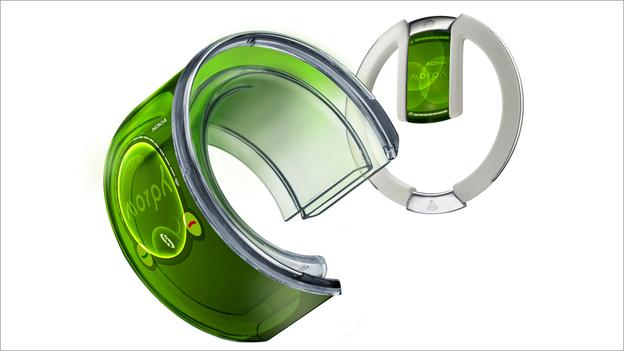Electronics giant Samsung is one of many companies that have shown “bendy phone” prototypes, made using so-called flexible OLED technology.
Mobile phones that fold, razor thin handsets powered by flexible batteries or see-through solar panels built directly into a colourful screen. These visions of our mobile future may seem a world away from our rigid, fragile and power-hungry smartphones today.
But they could all soon become reality thanks to the “wonder material” known as graphene. Believe the hype and these single-atom-thick sheets of carbon could soon replace just about every material and component used in modern day smartphones, making it lighter, faster and with more bells and whistles than ever before.
If these claims seem extraordinary, then so too is the material which could make them possible. Graphene is made of a single element, carbon, arranged in a flat, unchanging crystal pattern that looks like chicken wire. Although it may sound rare and complex it is simply very thin layers of graphite – the same as found in a common pencil. In fact it’s now realised that almost every stroke of a pencil leaves fragments of graphene in the shining grey trace on the paper.
What makes graphene remarkable is its ability to take on any of these roles. And what is more, it can conduct electricity better than copper, has strength greater than steel and also shows extraordinary elasticity. So great is its potential that in 2010 its discoverers Andre Geim and Konstantin Novoselov were awarded the Nobel prize for Physics.
So far, the smartphone screen is where most attention has been paid publically.
The material is cheap, see-through and critically is electrically conductive. That makes it ideal for the flat-screen displays used on smart phones that need electricity to power the optical elements, and to respond to the user touch.
Samsung and Nokia have already shown off concepts for “bendy” phones – such as the newly unveiled Samsung “YOUM” screen or the Nokia morph concept -with shapes unlike anything seen today. Although less extreme versions of some of these concepts may first be brought to market using more conventional technology, Nokia researchers believe that “graphene may well be one of the crucial elements of making Morph reality”.
Although these kinds of concepts excite the imagination and show the possibilities of graphene, durability is where the greatest interest lies. What the industry really wants is a touch screen a user can stab thousands of times a day without fear of the electronics ever giving out. Again, that’s what makes graphene so attractive.
The list of potential uses of graphene goes on – as a replacement for the flash memory of our SD cards, or to replace the metal antennae that pick up the radio signal. But one which shows just how varied the material’s properties can be is its use in the earpiece
All of these developments could play a part in the flexible future of the mobile industry. But perhaps, where graphene has caused the most excitement is within the chip industry.
For the past 50 years, the industry has been relentlessly driven by Moore’s law – which states that the number of transistors that can be squeezed onto an area of silicon for a fixed price double roughly every 18 months. As a result, silicon firms continually design and manufacture electronic components of ever-shrinking size, the reason more than a billion components can be squeezed onto a chip just a centimetre or two across. But each generation of shrinkage has become harder, and how to keep going beyond the horizon three or four generations away has long been a worry.
Although, the raw components to develop this phone exist, it is expected to be at least a decade or so before large-scale integration of huge numbers of graphene components will be a reality. But by then, silicon may already have maxed out.

